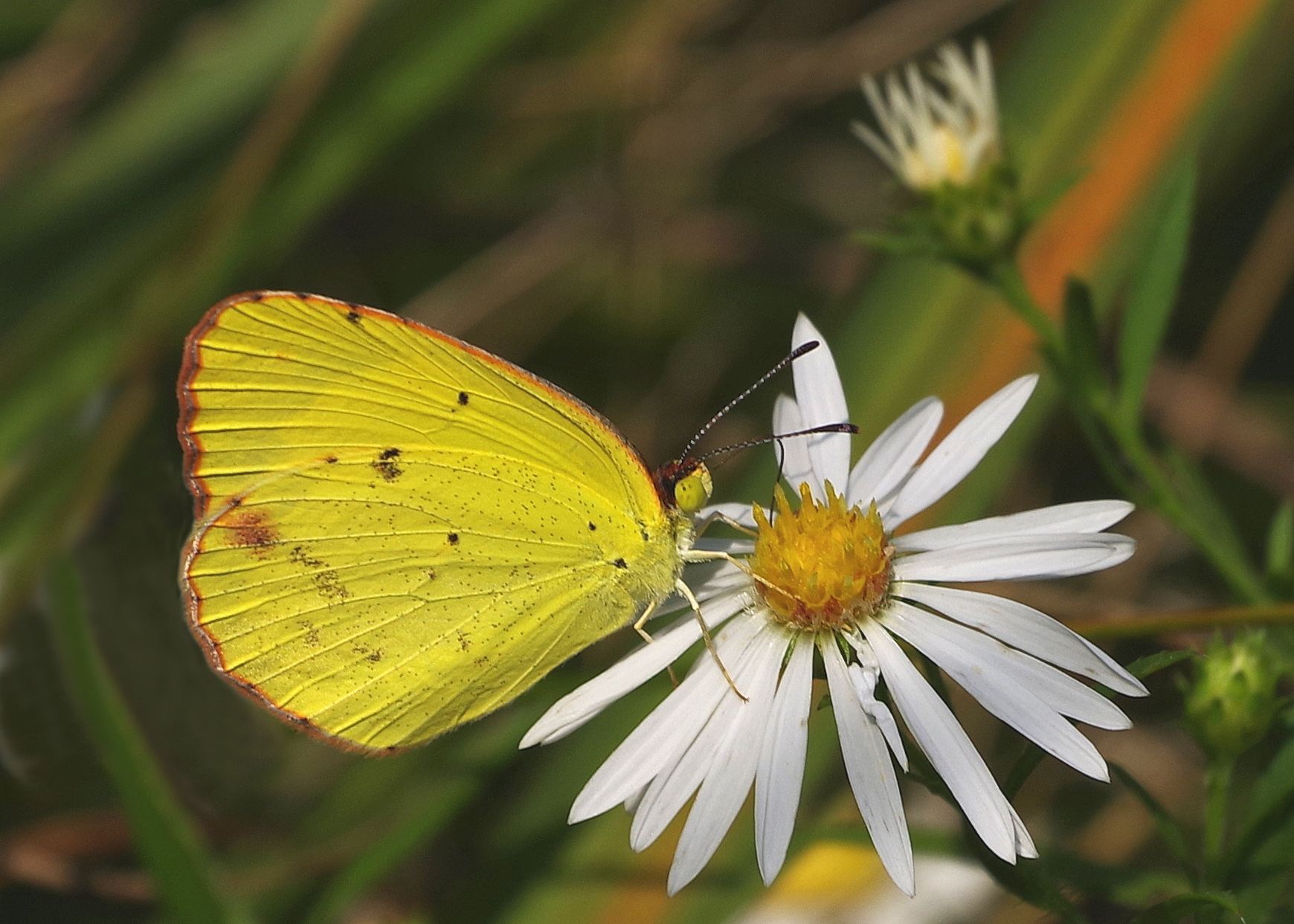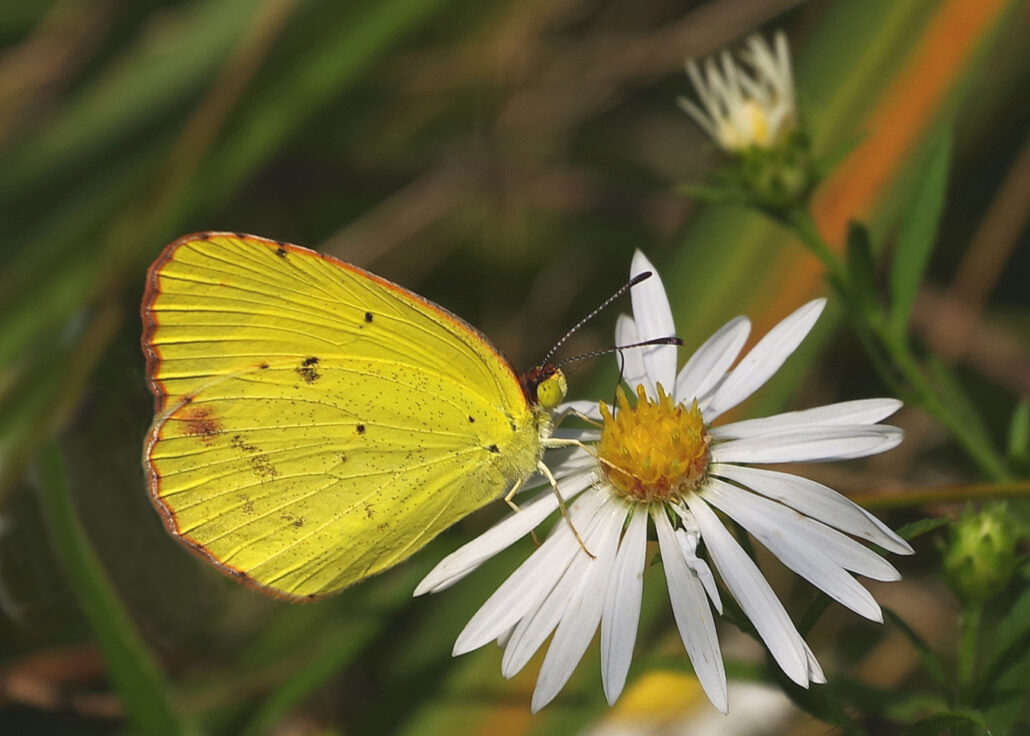
by Kate Redmond
Little Yellow Butterfly
Howdy, BugFans,
When the BugLady was on the trail recently, a small, yellow butterfly flew by, just above the ground. It was noticeably smaller than the ubiquitous Orange and Clouded Sulphurs, but it zipped out of sight pretty fast. Mike Reese, host of the excellent Wisconsin Butterflies website (https://wisconsinbutterflies.org/) describes similar experiences “It has not been the easiest butterfly for me to observe. I have seen this butterfly in central Wisconsin several years and have attempted to photograph it. All the individuals I saw took off on a beeline for other areas, dancing calmly but surely away from me, never to be seen again.” Fortunately, the BugLady’s butterfly turned around, came back, and posed nicely.
It was a Little Yellow/Little Sulphur/Lisa Yellow (Pyristia lisa) (formerly Eurema lisa). Like the larger Sulphurs and the “Whites,” it’s in the family Pieridae. Its wingspread measures 1 ¼” to 1 ¾” (females are slightly larger than males, but otherwise males and females are very similar), and there are pale and dark forms, depending on the time of summer https://bugguide.net/node/view/1752987/bgimage, https://bugguide.net/node/view/898574/bgimage. The BugLady’s butterfly snapped its wings shut immediately; here’s one with wings open https://bugguide.net/node/view/1184957/bgimage
Little Yellows are southern butterflies, abundant in grasslands, open areas and along woodland and road edges and railroad tracks as far south as Central America and Costa Rica, but they migrate north in summer and are found from the Great Plains as far west as New Mexico and South Dakota, to the Atlantic Coast as far north as Canada. Their numbers in Wisconsin vary from year to year, and they may persist into October here, but the final generation of the summer turns around and heads back south again.

Males keep an eye out for females, and when they see one, they court by touching her with their legs and wings. The female responds by spreading her antennae so she can sense his pheromones. If she’s not interested, she flutters her wings or departs; if she is – https://bugguide.net/node/view/2299141/bgimage.
She lays her eggs on the midveins of the leaves of a host plant, and when the eggs hatch, the larvae feed on the tender leaf tissue between the veins, resting along the midrib (nice series of pictures https://bugguide.net/node/view/1036429). Adults live a brief 10 days.
Little Yellows may produce five generations in their southern breeding range, and those that reach Wisconsin and beyond will breed if they can find host plants, but they are too sensitive to the cold to survive winters above 40 degrees north latitude (Philadelphia, PA to Columbus, OH to Boulder, CO).
Most sources only list a few caterpillar host plants in the Pea/Legume family, specifically Partridge Pea, Wild Senna, and Mimosa strigulosa, a small mimosa shrub. Ebner, in his Butterflies of Wisconsin (1970), writes that clovers in the genus Trifolium are undoubtedly used as host plants by the Wisconsin populations. The butterflies nectar on aster and goldenrod, and crowds of males gather at the edge of puddles to sip minerals from the damp earth https://bugguide.net/node/view/432629/bgimage. Little Yellows are preyed on by crab spiders and ambush bugs and in the south, native praying mantises.
Little Yellows are small but mighty – they’re famous for mass migrations that take them far from home. In 1874, Samuel Scudder described a swarm that reached the Bermuda Islands, “Early in the morning, several persons living on the north side of the island perceived, as they thought, a cloud coming over from the northwest, which drew nearer and nearer to shore, on reaching which it divided into two parts, one of which went eastward and the other westward, gradually falling upon the land. They were not long in ascertaining that what they had taken for a cloud was an immense concourse of small yellow butterflies, which flitted about all the open, grassy surfaces in a lazy manner, as if fatigued after their long voyage over the deep. Fishermen out near the reefs, some miles to the north of the islands very early that morning, stated that numbers of these insects fell upon their boats, literally covering them.”
Magic.
Kate Redmond, The BugLady
Bug of the Week archives:
http://uwm.edu/field-station/category/bug-of-the-week/
